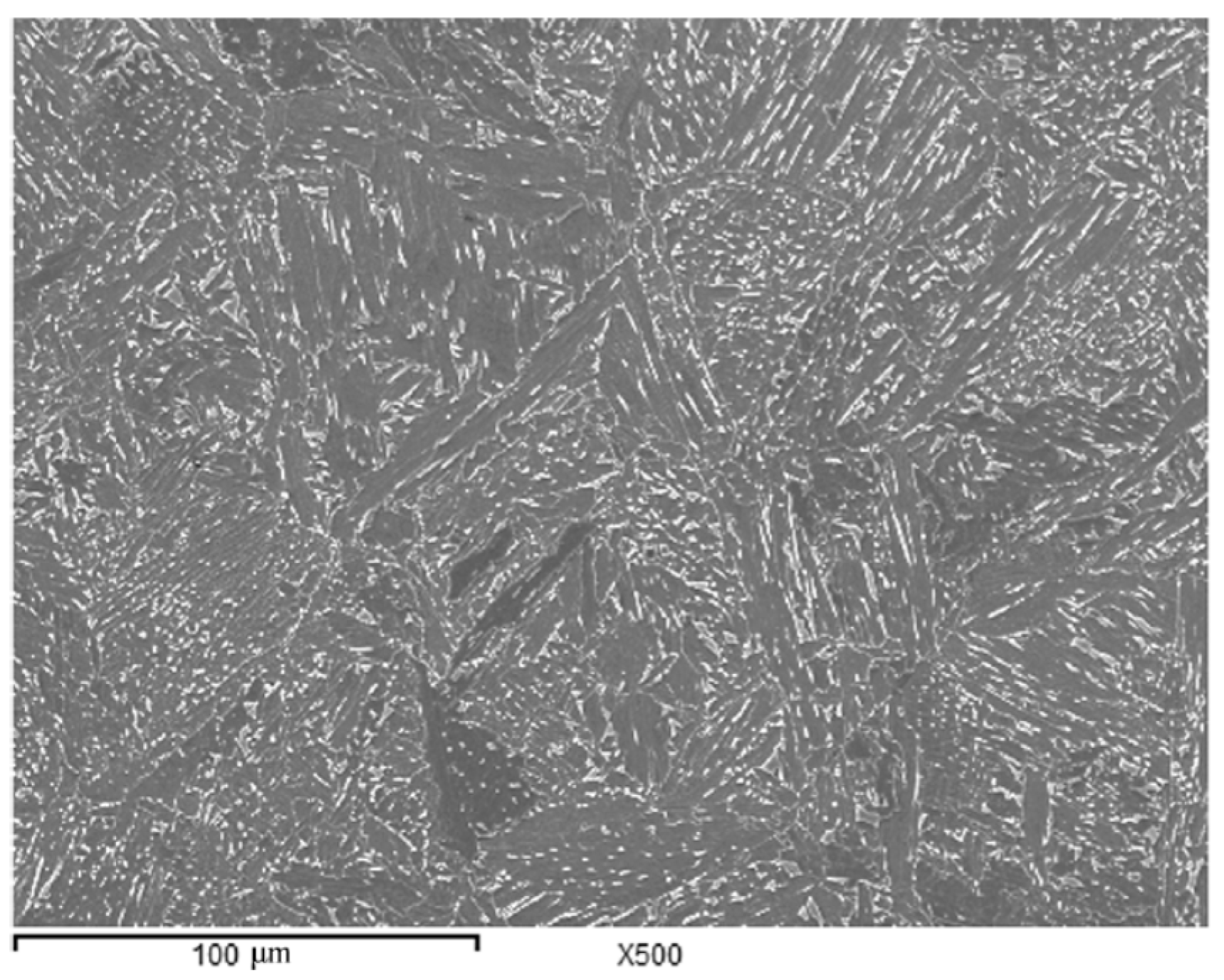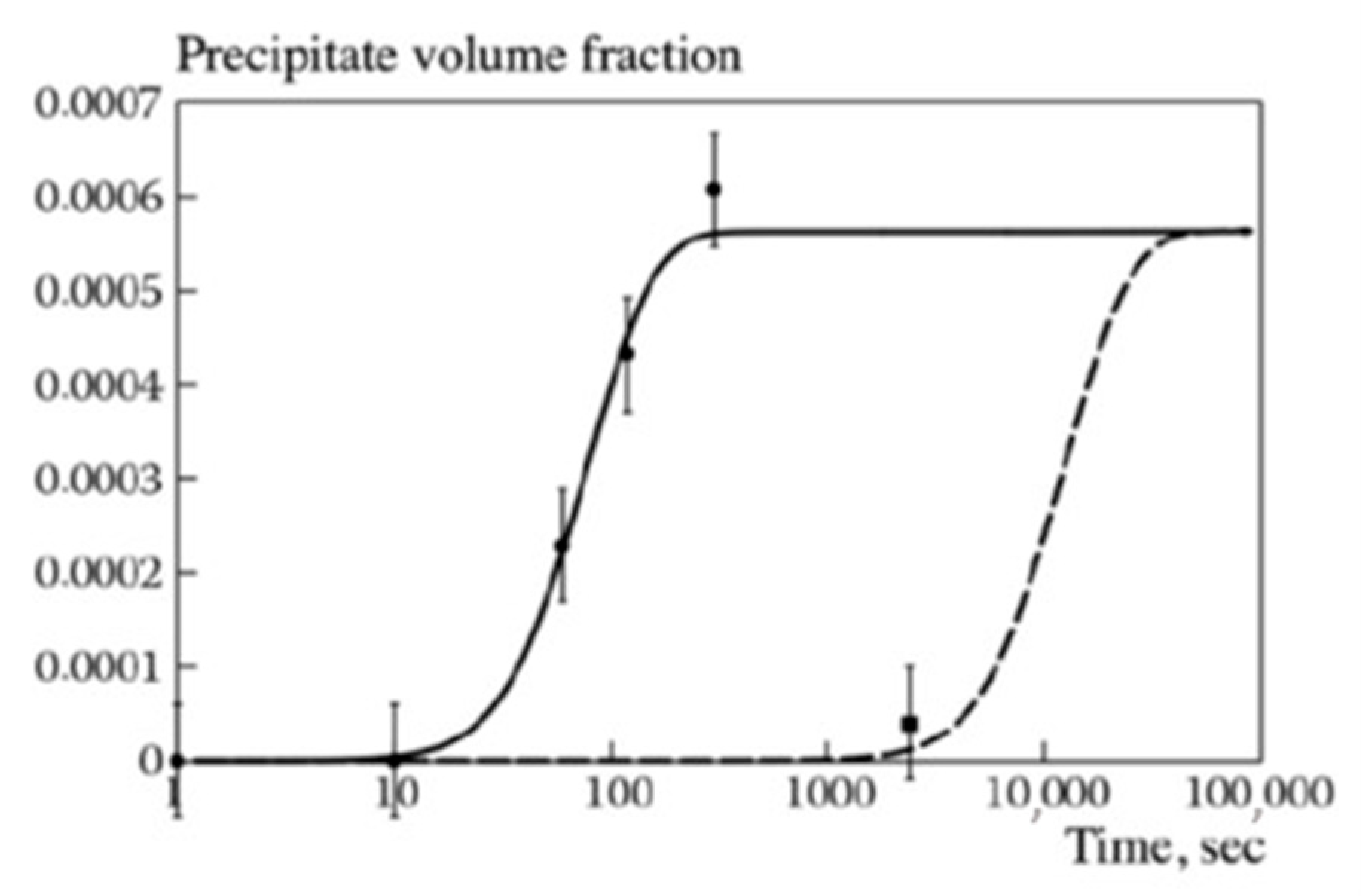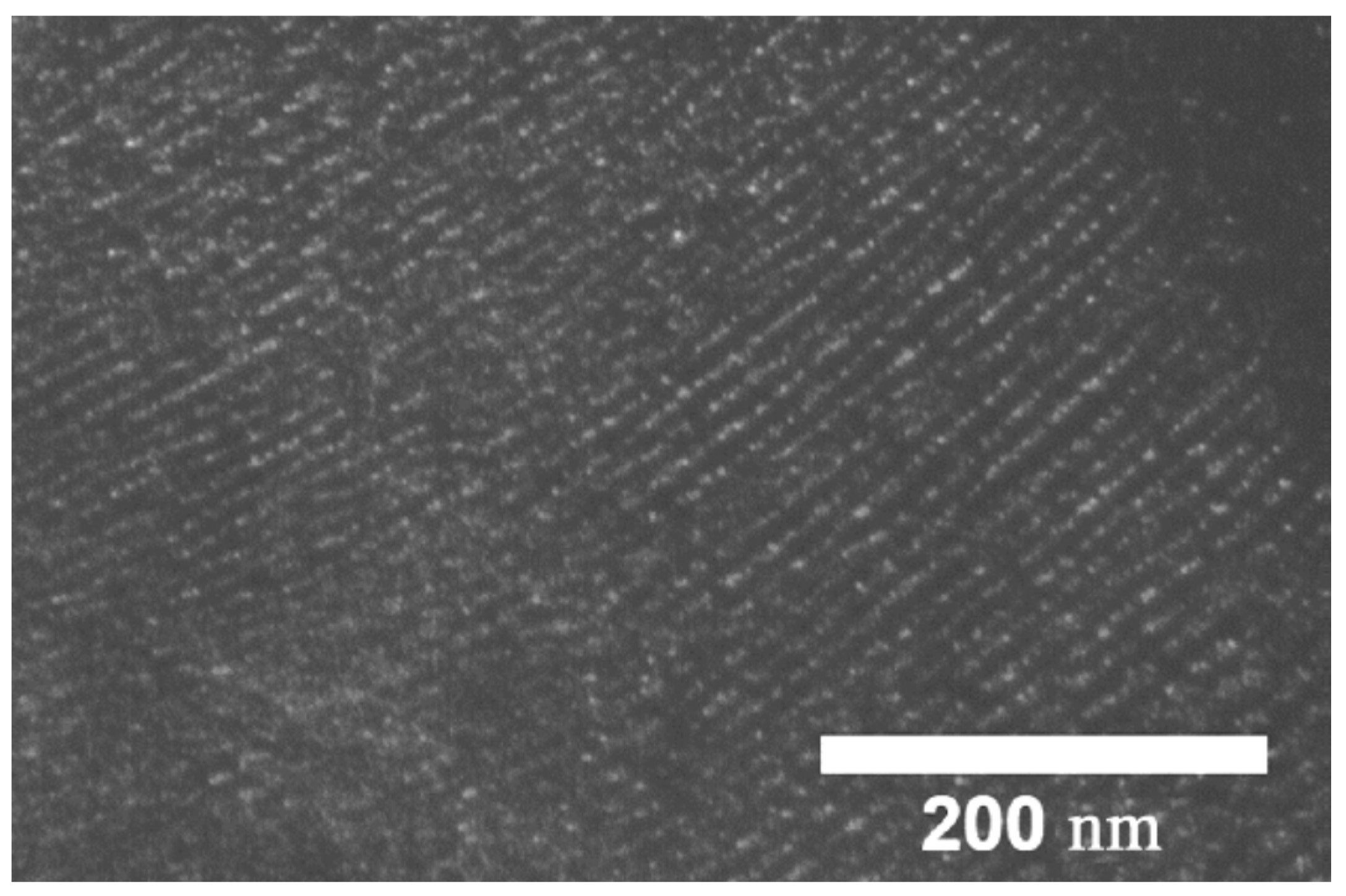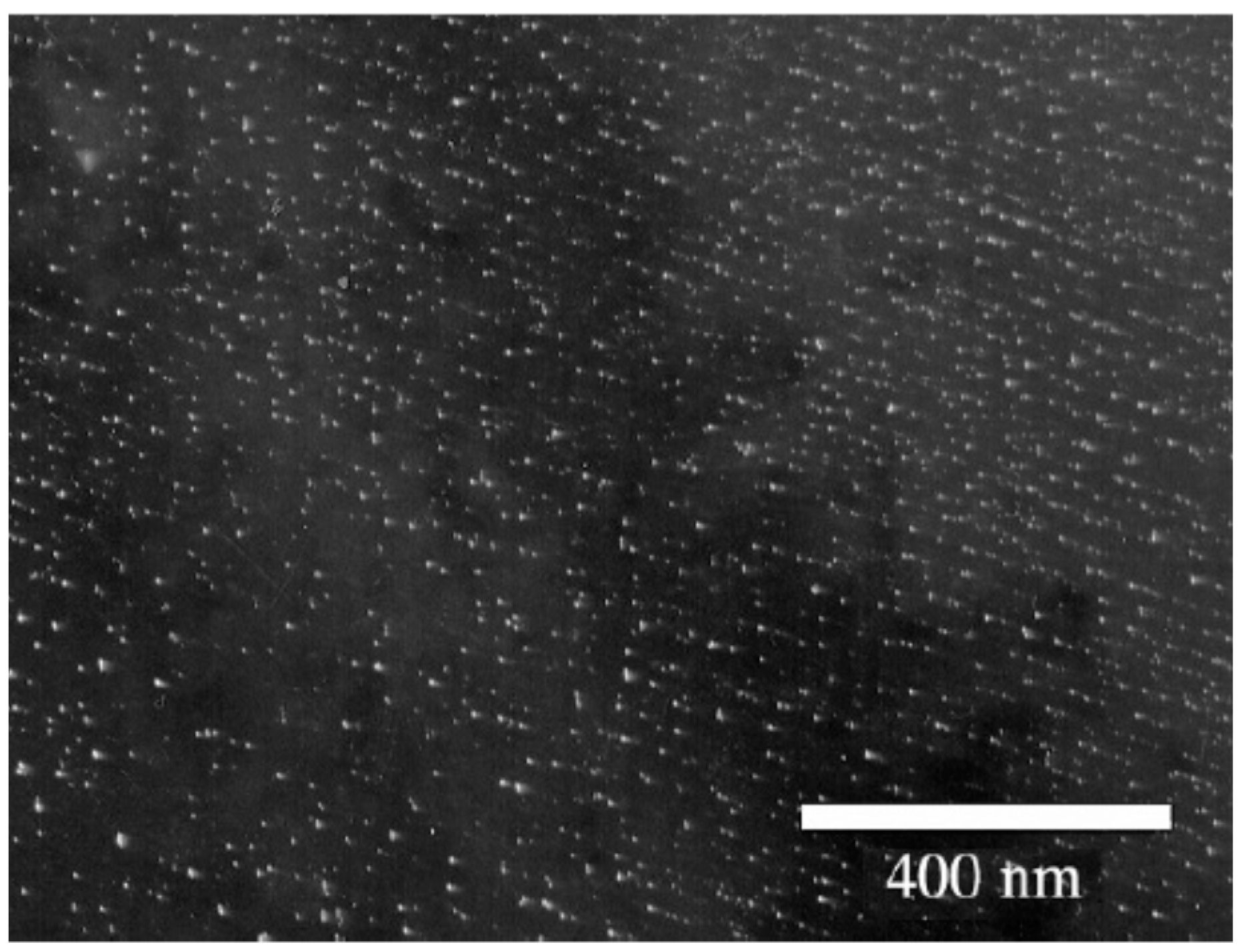Low-Carbon Ti-Mo Microalloyed Hot Rolled Steels: Special Features of the Formation of the Structural State and Mechanical Properties
Abstract
:1. Introduction
2. Implementation of the Main Strengthening Mechanisms
2.1. Grain-Boundary Strengthening
2.2. Peculiarities of the Acicular Ferrite Formation
2.3. Precipitation Strengthening
3. Influence of Chemical Composition
3.1. Strengthening Effect Due to (Ti, Mo)C Carbide Precipitation
3.2. Influence of Titanium Content
4. Influence of Thermo-Deformation Parameters
4.1. Influence of Temperatures of the Rolling End and Coiling
4.2. Influence of the Cooling Rate from Tf to Tc
5. Impact Toughness
6. Conclusions
Author Contributions
Funding
Institutional Review Board Statement
Informed Consent Statement
Data Availability Statement
Conflicts of Interest
References
- Funakawa, Y.; Shiozaki, T.; Tomita, K.; Yamamoto, T.; Maeda, E. Development of high strength hot-rolled sheet steel consisting of ferrite and nanometer-sized carbides. ISIJ Int. 2004, 44, 1945–1951. [Google Scholar] [CrossRef]
- Zhao, J.; Jiang, Z. Thermomechanical processing of advanced high strength steels. Prog. Mater Sci. 2018, 94, 174–242. [Google Scholar] [CrossRef]
- Villalobos, J.C.; Del-Pozo, A.; Campillo, B.; Mayen, J.; Serna, S. Microalloyed steels through history until 2018: Review of chemical composition, processing and hydrogen service. Metals 2018, 8, 351. [Google Scholar] [CrossRef] [Green Version]
- Baker, T.N. Titanium microalloyed steels. Ironmak. Steelmak. 2019, 46, 1–55. [Google Scholar] [CrossRef]
- Huo, X.; Xia, J.; Li, L.; Peng, Z.; Chen, S.; Peng, C. A review of research and development on titanium microalloyed high strength steels. Mater. Res. Express. 2018, 5, 062002. [Google Scholar] [CrossRef]
- Lagneborg, R.; Siwecki, T.; Zajac, S.; Hutchinson, B. The role of vanadium in microalloyed steels. Scand. J. Metall. 1999, 28, 186–241. [Google Scholar]
- DeArdo, A.J. Niobium in modern steels. Int. Mater. Rev. 2003, 48, 371–402. [Google Scholar] [CrossRef]
- Jonas, J.J.; Weiss, I. Effect of precipitation on recrystallization in microalloyed steels. Met. Sci. 2013, 13, 238–245. [Google Scholar] [CrossRef]
- Koldaev, A.V.; Zaitsev, A.I.; Krasnyanskaya, I.A.; D’yakonov, D.L. Study of the effect of composition and thermal deformation treatment on properties of ferritic steels microalloyed with titanium and niobium. Part 2. Phase precipitate characteristics. Metallurgist 2019, 63, 604–616. [Google Scholar] [CrossRef]
- Shaposhnikov, N.G.; Koldaev, A.V.; Zaitsev, A.I.; Rodionova, I.G.; D’yakonov, D.L.; Arutyunyan, N.A. Features of titanium carbide precipitation in low-carbon high-strength steels microalloyed with titanium and molybdenum. Metallurgist 2016, 60, 810–816. [Google Scholar] [CrossRef]
- Tang, Z.; Stumpf, W. The role of molybdenum additions and prior deformation on acicular ferrite formation in microalloyed Nb–Ti low-carbon line-pipe steels. Mater. Charact. 2008, 59, 717–728. [Google Scholar] [CrossRef]
- Xinjun, S. The roles and applications of molybdenum element in low alloy steels. In Proceedings of the International Seminar on Applications Mo in Steels, Beijing, China, 27–28 June 2010; Available online: https://www.imoa.info/download_files/proceedings/Mo-in-Steels-seminar-proceedings-2010-06_EN.pdf (accessed on 30 September 2021).
- Sarma, D.S.; Karasev, A.V.; Jonsson, P.G. On role of nonmetallic inclusions in the nucleation of acicular ferrite in steels. ISIJ Int. 2009, 49, 1063–1074. [Google Scholar] [CrossRef] [Green Version]
- Farrar, R.A.; Harrison, P.L. Acicular ferrite in carbon-manganese weld metals: An overview. J. Mater. Sci. 1987, 22, 3812–3820. [Google Scholar] [CrossRef]
- Lee, J.L.; Pan, Y.T. The formation of intragranular acicular ferrite in simulated heat-affected zone. ISIJ Int. 1995, 35, 1027–1033. [Google Scholar] [CrossRef] [Green Version]
- Ohkita, S.; Horii, Y. Recent development in controlling the microstructure and properties of low alloy steel weld metals. ISIJ Int. 1995, 35, 1170–1182. [Google Scholar] [CrossRef] [Green Version]
- Xiao, F.R.; Liao, B.; Shan, Y.Y.; Qiao, G.Y.; Zhong, Y.; Zhang, C.; Yang, K. Challenge of mechanical properties of an acicular ferrite pipeline steel. Mater. Sci. Eng. A 2006, 431, 41–52. [Google Scholar] [CrossRef]
- Yang, Z.; Wang, F.; Wang, S.; Song, B. Intragranular ferrite formation mechanism and mechanical properties of non-quenched-and-tempered medium carbon steels. Steel Res. Int. 2008, 79, 390–395. [Google Scholar] [CrossRef]
- Loder, D.; Michelic, S.K.; Bernhard, C. Acicular ferrite formation and its influencing factors—A review. J. Mater. Sci. Res. 2017, 6, 24–43. [Google Scholar] [CrossRef] [Green Version]
- Grong, O.; Kluken, A.O.; Nylund, H.K.; Dons, A.L.; Hjelen, J. Catalyst effects in heterogeneous nucleation of acicular ferrite. Metall. Mater. Trans. A 1995, 26, 525–534. [Google Scholar] [CrossRef]
- Lee, T.K.; Kim, H.J.; Kang, B.Y.; Hwang, S.K. Effect of inclusion size on the nucleation of acicular ferrite in welds. ISIJ Int. 2000, 40, 1260–1268. [Google Scholar] [CrossRef]
- Furuhara, T.; Yamaguchi, J.; Sugita, N.; Miyamoto, G.; Maki, T. Nucleation of proeutectoid ferrite on complex precipitates in austenite. ISIJ Int. 2003, 43, 1630–1639. [Google Scholar] [CrossRef]
- Jin, H.H.; Shim, J.H.; Ch, Y.W.; Lee, H.C. Formation of intragranular acicular ferrite grains in a Ti-containing low carbon steel. ISIJ Int. 2003, 43, 1111–1113. [Google Scholar] [CrossRef]
- Brooksbank, D.; Andrews, K.W. Stress fields around inclusions and their relation to mechanical properties. J. Iron Steel Inst. 1972, 210, 246–265. [Google Scholar]
- Mabuchi, H.; Uemori, R.; Fujioka, M. The role of Mn depletion in intra-granular ferrite transformation in the heat affected zone of welded joints with large heat input in structural steels. ISIJ Int. 1996, 36, 1406–1412. [Google Scholar] [CrossRef]
- Byun, J.S.; Shim, J.H.; Cho, Y.W.; Lee, D.N. Non-metallic inclusion and intragranular nucleation of ferrite in Ti-killed C–Mn steel. Acta Mater. 2003, 51, 1593–1606. [Google Scholar] [CrossRef]
- Shim, J.H.; Oh, Y.J.; Suh, J.Y.; Cho, Y.W.; Shim, J.D.; Byun, J.S.; Lee, D.N. Ferrite nucleation potency of non-metallic inclusions in medium carbon steels. Acta Mater. 2001, 49, 2115–2122. [Google Scholar] [CrossRef]
- Liu, Z.; Kobayashi, Y.; Yin, F.; Kuwabara, M.; Nagai, K. Nucleation of acicular ferrite on sulfide inclusion during rapid solidification of low carbon steel. ISIJ Int. 2007, 47, 1781–1788. [Google Scholar] [CrossRef] [Green Version]
- Shim, J.H.; Cho, Y.W.; Chung, S.H.; Shim, J.D.; Lee, D.N. Nucleation of intragranular ferrite at Ti2O3 particle in low carbon steel. Acta Mater. 1999, 47, 2751–2760. [Google Scholar] [CrossRef]
- Wang, M.; Cheng, G.; Qiu, S.; Zhao, P.; Gan, Y. Roles of titanium-rich precipitates as inoculants during solidification in low carbon steel. Int. J. Miner. Metall. Mater. 2010, 17, 276–281. [Google Scholar] [CrossRef]
- Gregg, J.M.; Bhadeshia, H.K.D.H. Solid-state nucleation of acicular ferrite on minerals added to molten steel. Acta Mater. 1997, 45, 739–748. [Google Scholar] [CrossRef]
- Wang, B.; Liu, X.; Wang, G. Inclusion characteristics and acicular ferrite nucleation in Ti-containing weld metals of X80 pipeline steel. Metall. Mater. Trans. A. 2018, 49, 2124–2138. [Google Scholar] [CrossRef]
- Loder, D.; Micheli, S.K.; Mayerhofer, A.; Bernhard, C. On the capability of nonmetallic inclusions to act as nuclei for acicular ferrite in different steel grades. Metall. Mater. Trans. B. 2017, 48, 1992–2006. [Google Scholar] [CrossRef] [Green Version]
- Kong, H.J.; Liu, C.T. A review on nano-scale precipitation in steels. Technologies 2018, 6, 36. [Google Scholar] [CrossRef] [Green Version]
- Kong, H.J.; Xu, C.; Bu, C.C.; Da, C.; Luan, J.H.; Jiao, Z.B.; Chen, G.; Liu, C.T. Hardening mechanisms and impact toughening of a high-strength steel containing low Ni and Cu additions. Acta Mater. 2019, 172, 150–160. [Google Scholar] [CrossRef]
- Jiang, S.; Wang, H.; Wu, Y.; Liu, X.; Chen, H.; Yao, M.; Gault, B.; Ponge, D.; Raabe, D.; Hirata, A.; et al. Ultrastrong steel via minimal lattice misfit and high-density nanoprecipitation. Nature 2017, 544, 460–464. [Google Scholar] [CrossRef] [PubMed]
- Jiao, Z.B.; Luan, J.H.; Miller, M.K.; Chung, Y.W.; Liu, C.T. Co-precipitation of nanoscale particles in steels with ultra-high strength for a new era. Mater. Today 2017, 20, 142–154. [Google Scholar] [CrossRef]
- Bu, F.Z.; Wang, X.M.; Yang, S.W.; Shang, C.J.; Misra, R.D.K. Contribution of interphase precipitation on yield strength in thermomechanically simulated Ti–Nb and Ti–Nb–Mo microalloyed steels. Mater. Sci. Eng. A 2014, 620, 22–29. [Google Scholar] [CrossRef]
- Zhang, K.; Li, Z.; Wang, Z.; Sun, X.; Yong, Q. Precipitation behavior and mechanical properties of hot-rolled high strength Ti–Mo-bearing ferritic sheet steel: The great potential of nanometer-sized (Ti, Mo)C carbide. J. Mater. Res. 2016, 31, 1254–1263. [Google Scholar] [CrossRef]
- Zhang, K.; Li, Z.-D.; Sun, X.-J.; Yong, Q.-L.; Yang, J.-W.; Li, Y.-M.; Zhao, P.-L. Development of Ti–V–Mo complex microalloyed hot-rolled 900-MPa-grade high-strength steel. Acta Metall. Sin. 2015, 28, 641–648. [Google Scholar] [CrossRef] [Green Version]
- Park, D.-B.; Huh, M.-Y.; Shim, J.-H.; Suh, J.-Y.; Lee, K.-H.; Jung, W.-S. Strengthening mechanism of hot rolled Ti and Nb microalloyed HSLA steels containing Mo and W with various coiling temperature. Mater. Sci. Eng. A 2013, 560, 528–534. [Google Scholar] [CrossRef]
- Phaniraj, M.P.; Shin, Y.M.; Lee, J.; Goo, N.H.; Kim, D.I.; Suh, J.Y.; Jung, W.S.; Shim, J.H.; Choi, I.S. Development of high strength hot rolled low carbon copper-bearing steel containing nanometer sized carbides. Mater. Sci. Eng. A 2015, 633, 1–8. [Google Scholar] [CrossRef]
- Yen, H.W.; Chen, P.Y.; Huang, C.Y.; Yang, J.R. Interphase precipitation of nanometer-sized carbides in a titanium–molybdenum-bearing low-carbon steel. Acta Mater. 2011, 59, 6264–6274. [Google Scholar] [CrossRef]
- Huang, Y.; Liu, W.; Zhao, A.; Han, J.; Wang, Z.; Yin, H. Effect of Mo content on the thermal stability of Ti-Mo-bearing ferritic steel. Int. J. Miner. Metall. Mater. 2021, 28, 412–421. [Google Scholar] [CrossRef]
- Funakawa, Y.; Fujita, T.; Yavada, K. Metallurgical features of NANOHITEN and application to warm stamping. JFE Tech. Rep. 2013, 18, 74–79. Available online: https://www.jfe-steel.co.jp/en/research/report/018/pdf/018-14-2.pdf (accessed on 30 September 2021).
- Sanz, L.; Pereda, B.; López, B. Effect of thermomechanical treatment and coiling temperature on the strengthening mechanisms of low carbon steels microalloyed with Nb. Mater. Sci. Eng. A 2017, 8, 377–390. [Google Scholar] [CrossRef]
- Sakuma, T.; Honeycombe, R.W.K. Microstructures of isothermally transformed Fe-Nb-C alloys. Met. Sci. 1984, 18, 449–454. [Google Scholar] [CrossRef]
- Sakuma, T.; Honeycombe, R.W.K. Effect of manganese on microstructure of an isothermally transformed Fe–Nb–C alloy. Mater. Sci. Technol. 1985, 1, 351–356. [Google Scholar] [CrossRef]
- Koldaev, A.V.; D’yakonov, D.L.; Zaitsev, A.I.; Arutyunyan, N.A. Kinetics of the formation of nanosize niobium carbonitride precipitates in low-alloy structural steels. Metallurgist 2017, 60, 1032–1037. [Google Scholar] [CrossRef]
- Chen, C.Y.; Chen, C.C.; Yang, J.R. Microstructure characterization of nanometer carbides heterogeneous precipitation in Ti–Nb and Ti–Nb–Mo steel. Mater. Charact. 2014, 88, 69–79. [Google Scholar] [CrossRef]
- Lee, W.B.; Hong, S.G.; Park, C.G.; Kim, K.H.; Park, S.H. Influence of Mo on precipitation hardening in hot rolled HSLA steels containing Nb. Scripta Mater. 2000, 43, 319–324. [Google Scholar] [CrossRef]
- Zaitsev, A.I.; Rodionova, I.G.; Arutyunyan, N.A.; Dunaev, S.F. Study of features of phase precipitation formation, structural state, and properties of ferritic class microalloyed low-carbon steels. Metallurgist 2020, 64, 750–758. [Google Scholar] [CrossRef]
- Zaitsev, A.; Koldaev, A.; Arutyunyan, N.; Dunaev, S.; D’yakonov, D. Effect of the chemical composition on the structural state and mechanical properties of complex microalloyed steels of the ferritic class. Processes 2020, 8, 646. [Google Scholar] [CrossRef]
- Khalid, F.A.; Edmonds, D.V. Interphase precipitation in microalloyed engineering steels and model alloy. Mater. Sci. Eng. 1993, 9, 384–396. [Google Scholar] [CrossRef]
- Chen, C.Y.; Yen, H.W.; Kao, F.H.; Li, W.C.; Huang, C.Y.; Yang, J.R.; Wang, S.H. Precipitation hardening of high-strength low-alloy steels by nanometer-sized carbides. Mater. Sci. Eng. A 2009, 499, 162–166. [Google Scholar] [CrossRef]
- Jia, Z.; Misra, R.D.K.; O’Malley, R.; Jansto, S.J. Fine-scale precipitation and mechanical properties of thin slab processed titanium–niobium bearing high strength steels. Mater. Sci. Eng. A 2011, 528, 7077–7083. [Google Scholar] [CrossRef]
- Zhang, Z.; Yong, Q.; Sun, X.; Li, Z.; Wang, Z.; Zhou, S.; Wang, G. Effect of Mo addition on the precipitation behavior of carbide in Nb-bearing HSLA steel. In HSLA Steels 2015, Microalloying 2015 & Offshore Engineering Steels 2015; Springer International Publishing: Cham, Switzerland, 2016; pp. 203–210. [Google Scholar] [CrossRef]
- Wang, Z.; Zhang, H.; Guo, C.; Liu, W.; Yang, Z.; Sun, X.; Zhang, Z.; Jiang, F. Effect of molybdenum addition on the precipitation of carbides in the austenite matrix of titanium micro-alloyed steels. J. Mater. Sci. 2016, 51, 4996–5007. [Google Scholar] [CrossRef]
- Kamikawa, N.; Abe, Y.; Miyamoto, G.; Funakawa, Y.; Furuhara, T. Tensile Behavior of Ti,Mo-added Low Carbon Steels with Interphase Precipitation. ISIJ Int. 2014, 54, 212–221. [Google Scholar] [CrossRef] [Green Version]
- Jang, J.; Heo, Y.; Lee, C.; Bhadeshia, H.; Suh, D.-W. Interphase precipitation in Ti–Nb and Ti–Nb–Mo bearing steel. Mater. Sci. Technol. 2013, 29, 309–313. [Google Scholar] [CrossRef]
- Jang, J.H.; Lee, C.H.; Heo, Y.U.; Suh, D.W. Stability of (Ti,M)C (M = Nb, V, Mo and W) carbide in steels using first-principles calculations. Acta Mater. 2012, 60, 208–217. [Google Scholar] [CrossRef]
- Wang, Z.; Chen, H.; Yang, Z.; Jiang, F. Decelerated coarsening of (Ti, Mo)C particles with a core–shell structure in austenite of a Ti-Mo-bearing steel. Metall. Mater. Trans. A 2018, 49, 1455–1459. [Google Scholar] [CrossRef]
- Wang, Z.; Sun, X.; Yang, Z.; Yong, Q.; Zhang, C.; Li, Z.; Weng, Y. Carbide precipitation in austenite of aTi–Mo-containing low-carbon steel during stress relaxation. Mater. Sci. Eng. A 2013, 573, 84–91. [Google Scholar] [CrossRef]
- Mohrbacher, H.; Sun, X.; Yong, Q.; Dong, H. MoNb-Based Alloying Concepts for Low-Carbon Bainitic Steels. In Advanced Steels; Weng, Y., Dong, H., Gan, Y., Eds.; Springer: Berlin/Heidelberg, Germany, 2011. [Google Scholar]
- Funakawa, Y.; Seto, K. Coarsening behavior of nanometer-sized carbides in hot-rolled high strength sheet steel. Mater. Sci. Forum. 2007, 539–543, 4813–4818. [Google Scholar] [CrossRef]
- Kim, Y.W.; Song, S.W.; Seo, S.J.; Hong, S.-G.; Lee, C.S. Development of Ti and Mo micro-alloyed hot-rolled high strength sheet steel by controlling thermomechanical controlled processing schedule. Mater. Sci. Eng. A 2013, 565, 430–438. [Google Scholar] [CrossRef]
- Koldaev, A.V.; Zaitsev, A.I.; Krasnyanskaya, I.A.; D’yakonov, D.L. Study of the effect of composition and thermal deformation treatment on properties of ferritic steels microalloyed with titanium and niobium. Part 1. Microstructure characteristics. Metallurgist 2019, 63, 487–495. [Google Scholar] [CrossRef]
- Larzabal, G.; Isasti, N.; Rodriguez-Ibabe, J.M.; Uranga, P. Evaluating strengthening and impact toughness mechanisms for ferritic and bainitic microstructures in Nb, Nb-Mo and Ti-Mo microalloyed steels. Metals 2017, 7, 65. [Google Scholar] [CrossRef] [Green Version]
- Chen, C.Y.; Liao, M.H. Synergistic effects of carbon content and Ti/Mo ratio on precipitation behavior of HSLA steel: Insights from experiment and critical patent analysis. Mater. Des. 2020, 186, 108361. [Google Scholar] [CrossRef]
- Rybkin, N.A.; Rodionova, I.G.; Shaposhnikov, N.G.; Kuznetsov, V.V.; Mishnev, P.A. Development of approaches for selecting the optimum alloying systems and production parameters for manufacturing hot-rolled high-strength low-alloy steels for automobile building. Metallurgist 2009, 53, 486–494. [Google Scholar] [CrossRef]
- Sun, X.; Li, Z.; Huo, X.; Wang, Z. Physical metallurgy of titanium microalloyed steel—recrystallization and phase transformation. In Titanium Microalloyed Steel: Fundamentals, Technology, and Products; Mao, X., Ed.; Springer: Singapore, 2019; pp. 141–184. [Google Scholar] [CrossRef]
- Lagneborg, R.; Zajac, S. A model for interphase precipitation in V-microalloyed structural steels. Metall. Mater. Trans. A 2001, 32, 39–50. [Google Scholar] [CrossRef]
- Zajac, S. Precipitation of microalloy carbo-nitrides prior, during and after γ/α transformation. Mater. Sci. Forum. 2005, 500, 75–86. [Google Scholar] [CrossRef]
- Echeverrı’a, A.; Rodriguez-Ibabe, J.M. The role of grain size in brittle particle induced fracture of steels. Mater. Sci. Eng. A 2003, 346, 149–158. [Google Scholar] [CrossRef]
- Zhang, L.P.; Davis, C.L.; Strangwood, M. Effect of TiN particles and microstructure on fracture toughness in simulated heat-affected zones of a structural steel. Metall. Mater. Trans. A 1999, 30, 2089–2096. [Google Scholar] [CrossRef]
- Liu, T.; Long, M.; Chen, D.; Duan, H.; Gui, L.; Yu, S.; Cao, J.; Chen, H.; Fan, H. Effect of coarse TiN inclusions and microstructure on impact toughness fluctuation in Ti micro-alloyed steel. J. Iron Steel Res. Int. 2018, 25, 1043–1053. [Google Scholar] [CrossRef]
- Linaza, M.A.; Romero, J.L.; Rodríguez-Ibabe, J.M.; Urcola, J.J. Influence of the microstructure on the fracture toughness and fracture mechanisms of forging steels microalloyed with titanium with ferrite-pearlite structures. Scripta Metall. Mater. 1993, 29, 451–456. [Google Scholar] [CrossRef]
- Sung, H.K.; Sohn, S.S.; Shin, S.Y.; Lee, S.; Kim, N.J.; Chon, S.H.; Yoo, J.Y. Effects of finish rolling temperature on inverse fracture occurring during drop weight tear test of API X80 pipeline steels. Mater. Sci. Eng. A 2012, 541, 181–189. [Google Scholar] [CrossRef]
- Ji, F.; Li, C.; Tang, S.; Yuan, G.; Wang, G. Microstructural characteristics with various finish rolling temperature and low temperature toughness in hot rolled Nb–Ti ferritic steel. ISIJ Int. 2016, 56, 602. [Google Scholar] [CrossRef] [Green Version]







| Chemical Composition | References |
|---|---|
| Ti2O3 | [26,29] |
| TiO2 | [31] |
| MnTi2O4 | [32] |
| (Ti,Al)Ox | [33] |
| TiN | [23] |
| Ti2O3-TiN | [23] |
| TiN-MnS | [23] |
| Ti2O3-Al2O3-MnS | [18] |
| TiOx-TiN-MnS | [13] |
| Ti- and Ti-Ca- oxy-sulfides | [15] |
| No. | Chemical Composition | Hot Rolling Parameters | Mechanical Properties | Ref. | ||||||||||||||
|---|---|---|---|---|---|---|---|---|---|---|---|---|---|---|---|---|---|---|
| C | Si | Mn | Mo | Ti | Cr | Ni | Al | P | S | N | Tf, °C | Tc, °C | Vc, °C/c | σ0.2, MPa | σB, MPa | δ, % | ||
| 1 | 0.043 | 0.18 | 1.62 | 0.19 | 0.092 | - | - | - | 0.008 | 0.001 | 0.0032 | 900 | 620 | 10 | ~780 | ~800 | ~23 | [1] |
| 2 | 0.045 | 0.19 | 1.53 | 0.20 | 0.119 | - | - | - | 0.009 | 0.001 | 0.0031 | 900 | 620 | 10 | ~780 | ~820 | ~18 | |
| 3 | 0.046 | 1.30 | 0.19 | 0.099 | 0.042 | 0.001 | 0.0028 | 950 | 600 | 10 | 683 | 786 | [65] | |||||
| 4 | 0.07 | 0.32 | 1.34 | 0.2 | 0.09 | 0.04 | 900 | 650 500 | 10 | 642 | 770 | 16.6 | [42] | |||||
| 5 | 0.079 | 0.17 | 1.22 | 0.43 | 0.19 | 0.03 | 0.0038 | 0.0052 | 0.0048 | 870 | 600 | ~30 | 912 | 971 | 16 | [39] | ||
| 6 | 0.048 | 0.20 | 1.61 | 0.20 | 0.09 | 0.02 | 0.020 | 0.006 | 0.0040 | 900 | 650 | 15 | 747 | 807 | 27 | [68] | ||
| 7 | 0.059 | 0.30 | 1.490 | 0.193 | 0.233 | 900 | 500 | 10 | 858 | 941 | [41] | |||||||
| 8 | 0.075 | 0.20 | 1.75 | 0.275 | 0.17 | 0.16 | 0.175 | 0.035 | 0.005 | 880 | 620 | 20 | 860 | 951 | 23.5 | [66] | ||
| 9 | 0.070 | 0.030 | 1.64 | 0.22 | 0.090 | 0.050 | 0.04 | 0.030 | 0.008 | 0.006 | 0.009 | 870 | 600 | 11 | 649 | 771 | 19.5 | [10] |
| 900 | 620 | 28 | 717 | 767 | 15 | |||||||||||||
| 10 | 0.063 | 0.063 | 1.61 | 0.21 | 0.096 | 0.021 | 0.01 | 0.057 | 0.003 | 0.003 | 0.003 | 850 | 650 | 8 | 694 | 777 | 19.6 | |
| 910 | 620 | 23 | 725 | 780 | 16.5 | |||||||||||||
| 11 | 0.052 | 0.05 | 1.51 | 0.17 | 0.12 | 0.053 | 0.003 | 0.003 | 0.003 | 890 | 650 | ~20 | 814 | 897 | 19 | |||
| 12 | 0.08 | 0.15 | 1.24 | 0.21 | 0.092 | 0.03 | 0.01 | 0.11 | 0.003 | 0.005 | 0.010 | 900 | 650 | 10–15 | 590 | 670 | 17 | [67] |
| 30 | 720 | 810 | ||||||||||||||||
| 13 | 0.08 | 0.16 | 1.39 | 0.21 | 0.165 | 0.03 | 0.01 | 0.13 | 0.003 | 0.005 | 0.009 | 900 | 650 | 10–15 | 770 | 840 | 15 | |
| 30 | 890 | 950 | ||||||||||||||||
Publisher’s Note: MDPI stays neutral with regard to jurisdictional claims in published maps and institutional affiliations. |
© 2021 by the authors. Licensee MDPI, Basel, Switzerland. This article is an open access article distributed under the terms and conditions of the Creative Commons Attribution (CC BY) license (https://creativecommons.org/licenses/by/4.0/).
Share and Cite
Zaitsev, A.; Arutyunyan, N. Low-Carbon Ti-Mo Microalloyed Hot Rolled Steels: Special Features of the Formation of the Structural State and Mechanical Properties. Metals 2021, 11, 1584. https://doi.org/10.3390/met11101584
Zaitsev A, Arutyunyan N. Low-Carbon Ti-Mo Microalloyed Hot Rolled Steels: Special Features of the Formation of the Structural State and Mechanical Properties. Metals. 2021; 11(10):1584. https://doi.org/10.3390/met11101584
Chicago/Turabian StyleZaitsev, Alexander, and Nataliya Arutyunyan. 2021. "Low-Carbon Ti-Mo Microalloyed Hot Rolled Steels: Special Features of the Formation of the Structural State and Mechanical Properties" Metals 11, no. 10: 1584. https://doi.org/10.3390/met11101584
APA StyleZaitsev, A., & Arutyunyan, N. (2021). Low-Carbon Ti-Mo Microalloyed Hot Rolled Steels: Special Features of the Formation of the Structural State and Mechanical Properties. Metals, 11(10), 1584. https://doi.org/10.3390/met11101584






